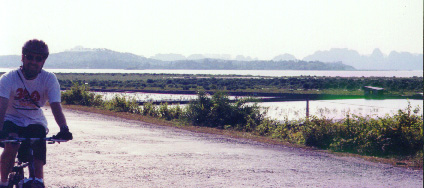

|
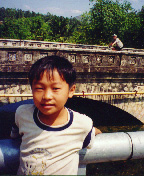 This lad insisted on a photo opportunity, so I obliged.
|
Zhi Wei had decreed an early breakfast and departure for this long day, a ride of 70 miles up the delta to the town of Sau Do. We rode along the bay and turned inland, soon beyond the traffic of the town. The weather was delightful, almost what you might call cool. There were still a few karsts about; one of them was being gouged out for its limestone. That seemed a shame, but with the equipment at hand, it looked like it would be a while before they made a significant dent in the landscape.
|
|
Something we used to
see on the Potomac during the C&O Canal era -- the coal
trade carried up and down river in very similar boats. |
|
|
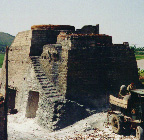 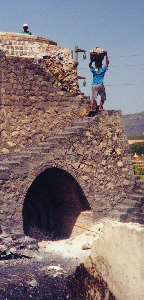
|
The first 20 miles went by rather breathlessly, bringing me to a fork in the highway at a small town. I chose the straighter path, and in another half-mile came to a bridge over a small river. Here they were loading coal into boats that looked suspiciously like the old C&O Canal boats. I took a few pictures and then wondered if I had taken the wrong fork. The other roads started to congregate back in the town when I got back, and, yes, I was on the right track. Further down the road, I began to see signs of industry -- brick kilns, limestone kilns for cement. I was particularly interested in the latter. I had made a study out of some of the old limestone kiln ruins on the Potomac, but it was a technology that had died out in the early 1900's. Here it was not only extant, it was thriving, as cement ranked as one of the country's major products (at least according to the World Factbook). I was cycling with Manchurian Dong when I stopped a second time to photograph a kiln. With his encouragement, we motioned our good intentions to the laborers and climbed up the narrow exterior steps to the top. One man was shoveling coal into the top of the kiln, the other one was carrying baskets of limestone rocks up and dumping it in. I'm not sure how it works, but the rock comes out the other end calcified, white as ash. Then it was loaded into one of the ubiquitous dark green trucks, probably off to the mill to be ground up, later to reappear in our travels as piles of cement next to piles of sand, ready for mixing and application. We saw many houses and other buildings under construction along the road, as well as sidewalks
|
|
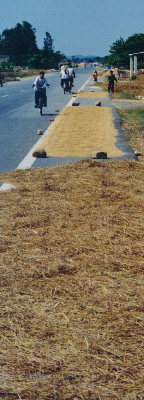
|
We began to see more and more houses alongside the road, sometimes with a side lane for bikes and pedestrians, separated by a narrow median strip. In some cases, the residents had left piles of rice straw on the road in front of their houses, letting the wheeled traffic do some threshing for them. I tried to oblige, but sometimes too much straw got wrapped around the gears, and I'd detour back onto the main highway. By lunchtime we had gone nearly 50 miles up the Delta, with no perceptible grade whatsoever. The guides gathered us together at the Caltex station and convinced us to take the last five miles to the next town on the bus. While riding the bus, we were treated to the heartening sight of the Ha Long Bicycle Club out for a brisk ride on their road bikes, dressed in the jet black Lycra jerseys and shorts. We hailed them from the windows -- the first and last recreational cyclists that I can recall seeing on the trip.
We found the bike shops becoming more elaborate on this modern thoroughfare. The shops were still quite modest, but they boasted air compressors in many cases, and tools capable of taking on even motorbikes. The signs outside advertised "Sua Xedap" (repair bicycle) or "Xe may", another word for bicycle. "Xe lam" was a motorbike, shortened from the once-pervasive "Lambretta" model. "OTO" turned out to be a phonetic spelling of our familiar "auto," but I eventually deduced that the brightly colored little triangular flags for OMO referred to a detergent. |
|
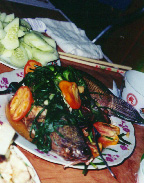 A whole fish for lunch, plus "les escargots." 
|
The restaurant in town looked like it might have once been a garage. A posse of motor bikes were lined up along the driveway where we parked, next to a patio area with plastic chairs. Once in the dimly-lit unfinished interior, we passed by a large square pit in the concrete floor, where it looked like some clothes washing was being done. (I fervently hoped the dark waters didn't conceal any plates or utensils.) We were ushered into a glassed-in private room, adorned by a couple of Pre-Raphaelite women in the buff. Some of the women expressed concern about the wall decorations. I tried to smooth things over by assuring them that the nudes were "a celebration of femininity." "That puts in the best light," they assured me, with perhaps a trace of irony. The now-familiar procession of soup, noodles, and unidentifiable meats began again. I had the noodles, waited eagerly for the rice. I had no doubt I was losing weight on the trip, which is rare for us carbo-loading bikers. Felt great, though. As some have pointed out, the staple diet is actually quite sensible.
|
|
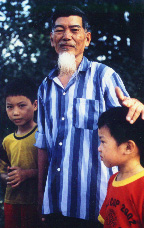 (photo by richard beattie) |
I figured a 50-mile day was plenty, so I opted for the van after lunch. We stopped unexpectedly at one roadside shop, and Ha Long Dong led us down a dirt road past some new construction (a district government building). On our left was a long wall shielding small houses, with occasional entryways and alleys. He stepped into one entrance, then backtracked and led us into a small compound. A middle-aged man and his wife invited us in and brought us tea. They marveled at our hair and made much of my arms (huge to them!). Our guide was not quite forthcoming as to the identity of our hosts -- I asked if they were family or friends, but got no answer. Out in the small courtyard, we were shown the cistern and a pump from a well. Four or five piglets were playing in the straw. A crowd of kids gathered at the entrance, and were edging their way in. We amused them with our cameras and I played with the house dog, who seemed a bit nervous, and then we were on our way back to the bus with no further explanation. We cruised by a compound with antiaircraft guns, and down a side road in the late afternoon light that eventually led us back to the main road and the town of Sau Do. This was a respectable-sized town, with newer and taller buildings out toward the highway, older residences and compounds as we turned down a narrow unpaved alley to the hotel. Despite its size, the town is almost invisible -- I haven't yet found it on any map and the only reference I've seen simply says that it has the most proximate lodgings to the Con Son pagoda. (Curious if we could have worked that into the stay.) Massages (the strictly therapeutic kind) were still cheap here, a matter of a few dollars, but I never seemed to be able to fit one into the schedule. There wasn't enough time before dinner, and afterwards I was too far gone to dreamtime for it to do much good.
|